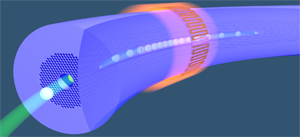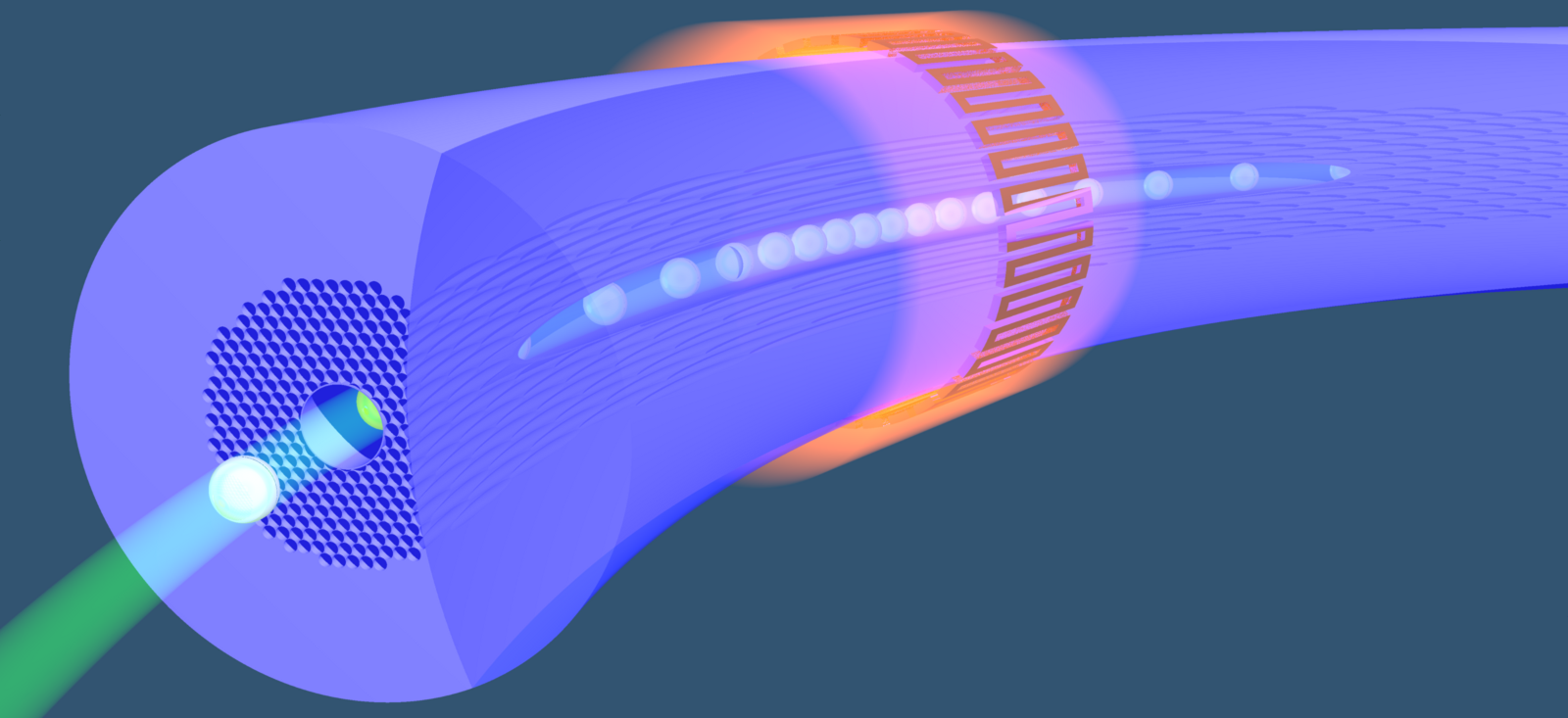Light and Heat in a Balancing Act
Physicists’ fascination with the light-matter interaction shows no sign of abating. Now, writing in Physical Review Letters, Oliver Schmidt and colleagues at the Max Planck Institute for the Science of Light in Erlangen, Germany, have demonstrated a novel form of trapping micron-sized particles, a technique that uses both light and thermal (optothermal) forces in tandem [1].
The branch of optical trapping started with the realization that light can exert miniscule forces on mesoscopic objects via radiation pressure (scattering) that guides or pushes microparticles or cells. When combined with forces resulting from the optical field gradient, this may result in single or multiple traps. Besides the very evocative link to tractor beams in science fiction, such trapping and guiding forces led to profound advances: single-molecule biophysics, colloidal and Brownian dynamics, and a deeper understanding of fundamental light fields [2]. In many of these applications, the trapped microparticle is itself a carefully calibrated, exquisite measurement device. While the vast majority of work has been performed with such traps in an aqueous environment, there has been a recent renaissance in particle trapping in air and vacuum, which is opening up new prospects for aerosol dynamics, microrheology, and even cavity optomechanics [3].
However, optical forces are not the only ones at work at the microscale. Both a particle and its environment can absorb light, and this can lead to nonuniform temperature gradients across a microparticle, such that molecular collisions with such objects creates a momentum imbalance across the surface. This occurs because molecules colliding with the “hot” side leave with more momentum than those colliding with the cooler side. The resulting “photophoretic” force can trap and guide particles over incredible distances—on the order of centimeters—in air [4].
In Schmidt et al.’s study [1], rather than using a free-space system, the authors exploited the attributes of a hollow-core photonic crystal fiber (HC-PCF) and guided a micrometer particle loaded into its air-filled hollow core (Fig. 1). Among an HC-PCF’s exceptional properties is the capacity to support guided modes essentially without decay, which is in stark contrast to a standard hollow glass capillary. An HC-PCF may be considered as an optical fiber with a two-dimensional periodic array of air holes in the cladding. In a typical case, an existence of photonic band gaps within such periodical structure prevents the light from propagating within the cladding, thus facilitating light confinement in the fiber core. Hence it offers a natural choice for long distance guiding and manipulation of microscopic particles within a confined geometry.
The team performed a number of experiments with the particle confined within the HC-PCF system, introducing thermal forces in a controlled manner. The first involved a cylindrical heating element placed cm from the launch point of the particle, which induced a temperature gradient . The authors observed a reduced (but constant) velocity in the heated region as a consequence of locally increased viscosity (which scales with temperature). The particle then regained its initial velocity after leaving this region, implying that the temperature gradient at the edge of the heating element dictated the particle dynamics. The authors ruled out optical mode variations as a dominant mechanism, since they were seen to contribute only to the variations in speed. A balance between the optical and thermal forces above a threshold stopped the particle, and the threshold depends linearly on laser guiding power. The authors backed up this observation with numerical studies, which showed that this stopping effect is related to thermal creep flow (TCF), which influences the velocity of a particle’s motion due to a temperature gradient. TCF occurs at the particle surface (this is known as thermoporesis) and at the fiber core walls, pushing gas molecules towards the hotter regions. This induces a pressure gradient along the fiber core with the highest pressure occurring at the center of the heating element. As a result, this drives a return flow of gas along the center of the core, manifesting itself as a viscous drag, dominating particle motion within the vicinity of the healing element edges. The authors quantified the effect of TCF at the particle surface and at the fiber core wall. By altering the optical power, the thermal and optical forces could be balanced, leaving the particle stationary in the fiber, at the heating element. This threshold optical power scales linearly with the temperature of the heating element.
A second experiment explored a configuration where a particle was guided along the fiber, but this time the outside of the fiber was coated with an absorbing material. In this case, the very forward scattered optical field from the particle is absorbed by this region, which is about mm in length, causing a local heating effect. Again, an optothermal trapping position was seen due to the balance of force that fluctuated only by a few microns upon varying the laser guiding power. Marking the fiber asymetrically (only on the top) still resulted in uniform transverse heating due to the very rapid (microsecond) diffusion time across the fiber. The conclusions meant any transverse thermal forces could be discarded as a contribution.
Finally, by employing a counterpropagating beam approach, in which light of different wavelengths is sent into the fiber from both directions, the authors were able to control the motion of the micrometer bead into the absorptive region, and a reduction in particle velocity was seen in all instances. Passing through the “hotspot,” the particle recovers its entry velocity. The observed asymmetry from the across the mark reverses the sign of the drag force.
By using all these configurations, the optothermal force on the particle, which can be accurately measured in hollow-core fiber by balancing it against the radiation forces, turns out to exceed the conventional thermophoretic force by two orders of magnitude. The HC-PCF system allows very precise measurements to be made of thermal forces acting on small particles in confined geometries (difficult to achieve by other means), over a wide range of gas pressures, and is likely to be useful for fundamental studies of fluid dynamics. One may envisage new applications in optofluidics research [5], Schimidt et al.’s technique could be used to better control the motion of a cell or particle motion. Examples include new ways to separate particles based on size or other physical properties, or creating novel optothermal versions of optical chromatography [6].
In addition to the possible applications, the present work offers a new playground for understanding and exploiting the fascinating interplay between optical and thermal forces. Nanoplasmonics is another area that may benefit from this technique in systems where the role of plasmonic enhanced optical forces [7] versus the thermal force contribution to microparticle confinement remains unclear. Plasmonics is associated with a dissipative ohmic loss, which may result in deleterious thermal convection accompanying more conventional but enhanced optical forces from plasmon interactions. To circumvent this, recent studies explored trapping using a plasmonic nanopillar with an integrated heat sink [8]. Beyond this, a precise understanding and calibration of forces of thermal origin against those of optical origin in themselves may help understand the role of convective and thermophoretic interactions. In fact, some researchers believe that understanding these forces will be helpful in understanding the mechanisms behind prebiotic evolution [9]. Optical forces are feeling the heat—but this may not be such a bad thing!
References
- O. A. Schmidt, M. K. Garbos, T. G. Euser, and P. S. J. Russell, ”Reconfigurable Optothermal Microparticle Trap in Air-Filled Hollow-Core Photonic Crystal Fiber,” Phys. Rev. Lett. 109, 024502 (2012)
- K. Dholakia and T. Cizmar, “Shaping the Future of Manipulation,” Nature Photon. 5, 335 (2011)
- D. E. Chang, C. A. Regal, S. B. Papp, D. J. Wilson, J. Ye, O. Painter, H. J. Kimble, and P. Zoller, “Cavity Opto-Mechanics using an Optically Levitated Nanosphere,” Proc. Natl. Acad. Sci. U.S.A. 107, 1005 (2010)
- V. G. Shvedov, A. V. Rode, Y. V. Izdebskaya, A. S. Desyatnikov, W. Krolikowski, and Y. S. Kivshar, “Giant Optical Manipulation,” Phys. Rev. Lett. 105, 118103 (2010)
- C. Monat, P. Domachuk, and B. J. Eggleton, “Integrated Optofluidics: A New River of Light,” Nature Photon. 1, 106 (2007)
- S. J. Hart and A. V. Terray, “Refractive-Index-Driven Separation of Colloidal Polymer Particles Using Optical Chromatography,” Appl. Phys. Lett. 83, 5316 (2003)
- M. L. Juan, M. Righini, and R. Quidant, “Plasmon Nano-Optical Tweezers,” Nature Photon. 5, 349 (2011)
- K. Wang, E. Schonbrun, P. Steinvurzel, and K. B. Crozier, “Trapping and Rotating Nanoparticles Using a Plasmonic Nano-Tweezer with an Integrated Heat Sink,” Nat. Commun. 2, 469 (2011)
- D. Braun and A. Libchaber, “Trapping of DNA by Thermophoretic Depletion and Convection,” Phys. Rev. Lett. 89, 188103(2002)





